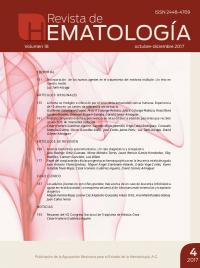Rev Hematol Mex. 2017 oct;18(4):187-192.
Herrera-Rojas M, Cid L, Quezada A, Ortiz A, Rosales-Salinas AM, Neira JC
Unidad de Hematología, Hospital Lomas de San Luis Potosí, SLP, México.
Resumen
Los protocolos de tratamiento pediátricos contra leucemia linfoblástica aguda (LLA) han mostrado beneficio en adolescentes y adultos jóvenes; sin embargo, el comportamiento de la enfermedad no es el mismo que en los niños porque 40% tendrá recaída con pronóstico adverso. El objetivo del tratamiento de la leucemia linfoblástica aguda en recaída es obtener remisión para realizar un trasplante alogénico de células hematopoyéticas (alo-TCH); sin embargo, ésta se obtiene en 18 a 44% de los casos con quimioterapia convencional. En este artículo se comunica la evolución de un paciente con leucemia linfoblástica aguda en recaída de alto riesgo que recibió tratamiento con inducción a la remisión con blinatumomab y venetoclax y posteriormente un alo-TCH. El caso corresponde a un paciente masculino de 32 años de edad con leucemia linfoblástica aguda B cromosoma Philadelphia negativo (LLA B PH-) atendido en mayo de 2016 con suspensión prematura del mantenimiento y recaída. Recibió inducción a la remisión con un esquema pediátrico con lo que permaneció con 33% de blastos, por lo que se inició blinatumomab en monoterapia con lo que permaneció con 45% de blastos; posteriormente se inició venetoclax con lo que se logró la desaparición de blastos de médula ósea, entonces se realizó un alo-TCH. En la actualidad el paciente cursa el día +90 postrasplante, con enfermedad mínima residual negativa medida por citometría de siguiente generación, quimerismo del 100% y biometría hemática normal. La modificación del esquema terapéutico inicial permitió que este paciente recibiera el alo-TCH en mejores condiciones, lo que aumenta la posibilidad de éxito.
PALABRAS CLAVE: leucemia linfoblástica aguda.
Young adults are not big children; more about a case of acute lymphoblastic leukemia in relapse treated with sequential scheme of blinatumomab-venetoclax and allogeneic transplant.
Rev Hematol Mex. 2017 October;18(4):187-192.
Herrera-Rojas M, Cid L, Quezada A, Ortiz A, Rosales-Salinas AM, Neira JC
Unidad de Hematología, Hospital Lomas de San Luis Potosí, SLP, México.
ABSTRACT
The pediatric treatment protocols for acute lymphoblastic leukemia (ALL) have shown benefit in adolescents and young adults; however, the behavior of the disease is not the same as in children since 40% presented with an adverse prognosis. The treatment’s objective of relapsed ALL is to obtain remission to perform an allogeneic transplant of hematopoietic stem cells (Allo-HSTC); however, it is obtained in 18 to 44% of the cases with conventional chemotherapy. In this clinical case we present the evolution of a patient with high-risk relapsed ALL who received induction treatment to remission with blinatumomab and venetoclax and subsequently an allo-HSCT. The case is about a 32-year-old male patient with acute lymphoblastic leukemia B negative Philadelphia chromosome diagnosed in May 2016 with premature suspension of maintenance therapy and subsequent relapse. The patient received induction to remission with a pediatric scheme, remaining with 33% blasts. Blinatumomab was started as monotherapy, remaining with 45% blasts, subsequently venetoclax was started, achieving the disappearance of bone marrow blasts, therefore an allo-HSCT was performed. Currently the patient is on the day +90 post transplant, with a negative minimal residual disease measured by next generation cytometry, 100% chimerism and normal peripheral blood cell count. The modification of the initial therapeutic scheme enabled this patient to receive the allo-HSCT in better conditions, increasing the possibility of success.
KEYWORDS: acute lymphoblastic leukemia

